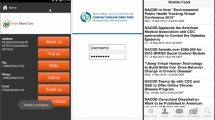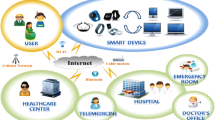Abstract
In modern society, interest in health is increasing and the development of medical devices and wireless communication enabled people to get healthcare services easily anytime and anywhere, i.e. ubiquitous healthcare. The development of IT convergence and network technology enabled users to obtain user-centered useful information easily through portable mobile devices as well as computers. Currently, healthcare related user-centered healthcare contents are being actively served and demand related to disease prevention or health promotion is steadily increasing. This paper proposes PHR-based life health index mobile services using a decision support model. A decision support model is developed by using health index related data of existing health weather index service and national health and nutrition survey provided by the Korea Meteorological Administration (KMA) and applications of the mobile environment are developed so that users can receive healthcare services easily anytime and anywhere. The developed mobile service application implemented its interface for the user’s convenient healthcare and was developed to enable interlocking with the user’s PHR information through web server. Unlike comprehensive and standardized index services of existing KMA health weather index and life health index service, the developed mobile service is serving the user’s health status in three stages of danger, alert, safety by using personalized PHR information. The development of the PHR-based life health index mobile service using the decision making model allowed users to check current health status index and obesity measurement, body mass index (BMI), abdominal obesity, potential obesity risk index etc. easily anytime and anywhere only with simple input in the interface of mobile application. Also, accurate and subdivided services can be offered to users and more personalized services enable users to use efficient healthcare service.









Similar content being viewed by others
Notes
The R project, www.r-project.org.
Korea Meteorological Administration, http://web.kma.go.kr/eng.
References
Jung, E. Y., Kim, J. H., Chung, K. Y., & Park, D. K. (2013). Home health gateway based healthcare services through U-health platform. Wireless Personal Communications, 73(2), 207–218.
Song, C. W., Lee, D., Chung, K. Y., Rim, K. W., & Lee, J. H. (2014). Interactive middleware architecture for lifelog based context awareness. Multimedia Tools and Applications, 71(2), 813–826.
Yang, J. H., Kim, J. K., Kang, U. G., & Lee, Y.-H. (2013). Coronary heart disease optimization system on adaptive-network-based fuzzy inference system and linear discriminant analysis. Personal Ubiquitous Computing, 17(7), 1315–1572.
Anooj, P. K. (2001). Clinical decision support system: Risk level prediction of heart disease using decision tree fuzzy rules. International Journal of Human Computer Interaction, 16(2), 97–166.
Jung, H., & Chung, K. (2015). Sequential pattern profiling based bio-detection for smart health service. Cluster Computing, 18(1), 209–219.
Jung, H., & Chung, K. (2015). Knowledge based dietary nutrition recommendation for obesity management. Information Technology and Management. doi:10.1007/s10799-015-0218-4.
Kim, S. H., & Chung, K. Y. (2013). Medical information service system based on human 3D anatomical model. Multimedia Tools and Applications. doi:10.1007/s11042-013-1584-8.
Kim, J. H., & Chung, K. Y. (2014). Ontology-based healthcare context information model to implement ubiquitous environment. Multimedia Tools and Applications, 71(2), 873–888.
Zheng, J. W., Zhang, Z. B., Wu, T. H., & Zhang, Y. (2007). A wearable mobihealth care system supporting real-time diagnosis and alarm. Medical Biological Engineering Computing, 45(9), 877–885.
Park, J. H., & Hwang, T. (2011). IT convergence healthcare technology. KICS Information and Communications Magazine, 28(5), 21–27.
Xiao, Y., Takahashi, D., Liu, J., Deng, H., & Zhang, J. (2011). Wireless telemedicine and m-health: Technologies, applications and research issues. International Journal of Sensor Networks, 10(4), 202–236.
Oh, S. Y., Ghose, S., Chung, K., Han, J. S. (2014). Recent trends in convergence based smart healthcare service. International Journal of Technology and Health Care, 22(3), 303–307.
Oh, S. Y., Ghose, S., Jeong, Y. K., Ryu, J. K., Han, J. (2015). Convergence security systems. International Journal of Computer Virology and Hacking, 11(3), 119–121.
Kim, J., Lee, J. (2015). Mobile, ubiquitous multimedia and digital convergence. Cluster Computing, 18(1), 243–245.
Chung, K., Oh, S. Y. (2015). Improvement of speech signal extraction method using detection filter of energy spectrum entropy. Cluster Computing, 18(2), 629–635.
Bodenheimer, T., Lorig, K., Holman, H., & Grumbach, K. (2002). Patient self-management of chronic disease in primary care. The Journal of the American Medical Association, 288(19), 2469–2475.
Chung, K. Y. (2014). Recent trends on convergence and ubiquitous computing. Personal and Ubiquitous Computing, 18(6), 1291–1293.
Chung, K., Boutaba, R., & Hariri, S. (2014). Recent trends in digital convergence information system. Wireless Personal Communications, 79(4), 2409–2413.
Korea Meteorological Administration. http://web.kma.go.kr/.
Kim, J. K., Lee, J. S., Park, D. K., Lim, Y. S., & Lee, Y. H. (2014). Adaptive mining prediction model for content recommendation to coronary heart disease patients. Cluster Computing, 17(3), 881–891.
Park, D., Kim, J., Kim, J., Jung, E., & Lee, Y. (2011). U-health service model for managing health of chronic patients in multi-platform environment. The Journal of the Korea Contents Association, 11(8), 23–32.
Kim, S. H., & Chung, K. (2015). Emergency situation monitoring service using context motion tracking of chronic disease patients. Cluster Computing, 18(2), 747–759.
Kim, H., Jo, J., Choi, Y., Oh, J., Lee, J., & Yoon, K. (2010). Ubiquitous health care system for chronic disease management. Journal of Korea Information and Communications Magazine, 27(9), 3–8.
Korea Centers for Disease Control and Prevention. (2012). In 6th Korean national health and nutrition examinations survey (KNHANES V-1). Centers for Disease Control and Prevention.
Kim, J. H., Lee, D., & Chung, K. Y. (2014). Item recommendation based on context-aware model for personalized U-healthcare service. Multimedia Tools and Applications, 71(2), 855–872.
Yen, Y. S., Chiang, W. C., Wang, H. Y., & Shiah, C. Y. (2011). WiMAX network for health care telemonitoring service. In Proceedings of the 2011 international conference on information science and applications (Vol. 1, pp. 1–7).
Lee, M. S. (2010). Chronic diseases, depressive symptoms and the effects of social networks in Korean elderly population. Korean Association of Health and Medical Sociology, 27, 5–30.
Jung, H., & Chung, K. Y. (2014). Discovery of automotive design paradigm using relevance feedback. Personal and Ubiquitous Computing, 18(6), 1363–1372.
Jung, H., Yoo, H., Lee, Y. H., & Chung, K. Y. (2015). Interactive pain nursing intervention system for smart health service. Multimedia Tools and Applications, 74(7), 2449–2466.
Fleischer, R. (1999). Decision trees: Old and new results. Information and Computation, 152(1), 44–61.
Friedman, M., Noy, T. B., Blau, M., & Kandel, A. (1998). Certain computational aspects of fuzzy decision trees. Fuzzy Sets and Systems, 28(2), 163–170.
Yeon, J., Lee, D., Shim, J., & Lee, S.-G. (2011). Product review data and sentiment analytical processing modeling. Journal of Society for E-Business Studies, 16(4), 125–137.
Chung, K. Y., Na, Y. J., & Lee, J. H. (2013). Interactive design recommendation using sensor based smart wear and weather WebBot. Wireless Personal Communications, 73(2), 243–256.
Agrawal, R., & Srikant, R. (1994). Fast algorithms for mining association rules. In Proceedings of the international conference on very large databases (pp. 487–499).
Agrawal, R., Imielinski, T., & Swami, A. (1993). Mining association rules between sets of items in large databases. In Proceedings of ACM SIGMOD on management of data (pp. 207–216).
Clifton, C., & Marks, D. (1996). Security and privacy implications of data mining. In Proceedings of international workshop on data mining and knowledge discovery, Montreal, Canada (pp. 15–19).
Han, J., Pei, J., Yin, Y., & Mao, R. (2004). Mining frequent patterns without candidate generation: A frequent-pattern tree approach. In Proceedings of international workshop on data mining and knowledge discovery (pp. 53–87).
Saygin, Y., Verykios, V. S., & Elmagarmid, A. K. (2002). Privacy preserving association rule mining. In Proceedings of international workshop on research issues in data engineering: Engineering e-commerce/e-business systems (pp. 151–158).
Jung, E. Y., Kim, J., Chung, K. Y., & Park, D. K. (2014). Mobile healthcare application with emr interoperability for diabetes patients. Cluster Computing, 17(3), 871–880.
Jung, H., & Chung, K. Y. (2014). Mining based associative image filtering using harmonic mean. Cluster Computing, 17(3), 767–774.
Chung, K. Y., & Lee, J. H. (2004). User preference mining through hybrid collaborative filtering and content-based filtering in recommendation system. IEICE Transaction on Information and Systems, 87(12), 2781–2790.
Olson, D., & Courtney, J. (1992). Decision support models and expert system. Macmillan Publishing Company.
Turban, E., Aronson, J., & Liang, T. P. (2005). Decision support systems and intelligent systems (7th ed.). Pearson Prentice Hall.
Park, R. C., Jung, H., Chung, K., & Yoon, K. H. (2015). Picocell based telemedicine health service for human UX/UI. Multimedia Tools and Applications, 74(7), 2519–2534.
Kim, J. H., Kim, J., Lee, D., & Chung, K. Y. (2014). Ontology driven interactive healthcare with wearable sensors. Multimedia Tools and Applications, 71(2), 827–841.
Chung, K., Kim, J. C., & Park, R. C. (2015). Knowledge based health service considering user convenience using hybrid Wi-Fi P2P. Information Technology and Management. doi:10.1007/s10799-015-0241-5.
Kim, S. H., & Chung, K. Y. (2014). 3D simulator for stability analysis of finite slope causing plane activity. Multimedia Tools and Applications, 68(2), 455–463.
Kim, J. C., Jung, H., Kim, S. H., & Chung, K. (2015). Slope based intelligent 3D disaster simulation using physics engine. Wireless Personal Communications. doi:10.1007/s11277-015-2788-1.
Acknowledgments
This work was supported by the Korea Foundation for the Advancement of Science and Creativity (KOFAC), and funded by the Korean Government (MOE).
Author information
Authors and Affiliations
Corresponding author
Rights and permissions
About this article
Cite this article
Jung, H., Chung, K. PHR Based Life Health Index Mobile Service Using Decision Support Model. Wireless Pers Commun 86, 315–332 (2016). https://doi.org/10.1007/s11277-015-3069-8
Published:
Issue Date:
DOI: https://doi.org/10.1007/s11277-015-3069-8




